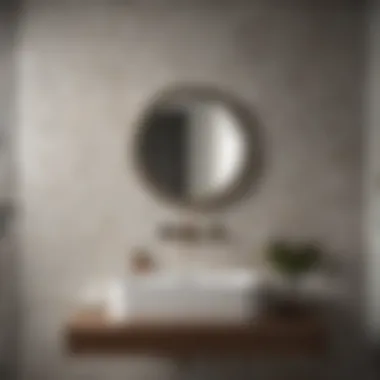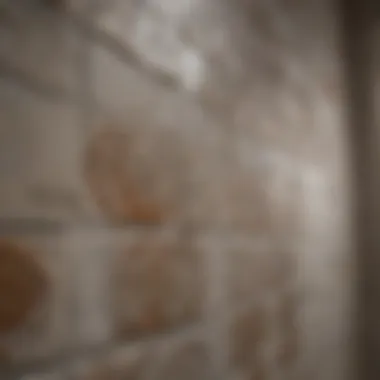Cost Breakdown for Installing Bathroom Wall Tile


Intro
When sprucing up a bathroom, one of the most visible and impactful changes you can make is the installation of wall tiles. However, this isn’t just about picking a tile that looks good—it's about understanding the costs involved to avoid unplanned financial surprises. A keen focus on the cost analysis of bathroom wall tile installation can save you more than just a few bucks; it can lead to a better decision-making process overall.
In this discussion, we’ll look at several key factors that influence the costs of tile installation—everything from the materials you choose to the labor involved in getting those tiles on your wall. Understanding tile options, typical pricing structures, and installation techniques can inform your budgeting and help you maximize your expenditure without compromising on aesthetics.
Let’s break it down, shall we?
This guide is tailored specifically for homeowners, especially for those who are keen to uplift their spaces but are wary of overspending. So grab a cup of tea and let’s explore the ins and outs of bathroom wall tile installation costs.
Intro to Bathroom Wall Tile Installation Costs
In any home renovation, installing bathroom wall tiles represents a significant opportunity to enhance both aesthetics and functionality. This article delves into the various costs associated with this process, which is not merely about picking pretty tiles, but encompasses a wide field of considerations.
When planning for wall tile installation, understanding the cost implications can help avoid unexpected financial surprises. Homeowners must navigate through the intricate landscape of materials, labor, and additional variables that contribute to the overall expenditure, shaping their decision-making process.
Understanding the Importance of Tile Selection
Choosing the right tile is akin to selecting the right clothes; it’s not just about looks, but also how it fits into your lifestyle and environment. The type of tile often dictates pricing, and an informed choice is crucial. Each tile type has its own characteristics, influences longevity, and prices can fluctuate considerably.
For instance, glazed ceramic tiles might provide a cost-effective solution but may lack the sophistication of natural stone tiles, which can significantly elevate the sophisticated style of a bathroom. This variance highlights that making the right choice goes beyond just the initial price tag.
Involvement in tile selection should encompass both practical needs and personal style preferences. If glass tiles are the go-to for a sleek, modern look, one must be prepared to sprinkle in a bit more cash into that budget compared to standard options. But here’s the thing: the joy of choosing suitable tiles contributes enormously to your space’s ambiance.
Why Accurate Cost Estimation Matters
Accurate cost estimation lays the groundwork for a successful tiling project, much like a sturdy foundation for a house. Homeowners often underestimate expenses, thinking all they need to do is pay for tiles and labor. In reality, additional costs can sneak in, catching folks off guard.
A well-rounded cost analysis should consider not only the cover materials but also labor fees, potential waste, and – often forgotten – the supplies needed to complete the job. By calculating the aggregate expenses beforehand, you are less likely to face the harrowing prospect of running out of funds mid-project.
"An ounce of prevention is worth a pound of cure" – this old saying definitely applies here.
Budgeting helps prioritize elements, distinguishing between must-haves and nice-to-haves, thus ensuring that the project remains within financial bounds without compromising on quality or desired aesthetic.
In summary, acquiring a full picture of installation costs and tile selection leads to well-informed decisions, safeguarding against regrettable missteps in the tiling journey. Through attention to detail and a solid grasp of spending variables, homeowners can confidently embark on the process of installing bathroom wall tile.
Factors Influencing Installation Costs
When it comes to installing bathroom wall tiles, understanding the various elements that impact costs is crucial. The overall expense can vary widely based on specific choices made during the selection process. This section digs into those elements—covering tile choice, labor considerations, and additional supplies—that not only shape the budget but can also affect the quality of the final installation.
Types of Tiles and Their Price Range
The selection of tiles plays a significant role in determining the installation cost due to the diverse price spectrum available in the market. Each type of tile presents distinct characteristics, advantages, and costs that should be considered carefully.
Glazed Ceramic Tiles
Glazed ceramic tiles are often regarded for their versatility and affordability. They come in a myriad of colors and patterns, making them a favorite for homeowners wanting to add a personal touch to their bathroom. One of the key features is the glazed finish that offers a durable, water-resistant surface.
However, while they are cost-effective, they can be prone to chipping or cracking if mishandled. For many, the benefits outweigh the drawbacks, solidifying their position as a top choice in the realm of bathroom tiles.
Porcelain Tiles
On the other hand, porcelain tiles take the spotlight for their robustness and low water absorption rate. They mimic the look of natural stone, which allows for elegant aesthetics without the accompanying maintenance. These tiles can be a pricier option, but their longevity often justifies the investment.
A distinctive trait is that they can be used in both residential and commercial settings, highlighting their durability. That said, they are heavy and can complicate installation if not handled with care.
Natural Stone Tiles
Natural stone tiles, such as granite or marble, are prized for their unique beauty. Each piece is one-of-a-kind, contributing to a luxurious finish. However, this beauty comes at a steep price, and the maintenance requirements can be more involved compared to other materials.
Natural stones are porous, which means they often need sealing to prevent staining. This can add an extra layer to the initial cost. The visual and tactile difference makes these a viable choice for those looking to invest in high-end appeal for their bathrooms.


Glass Tiles
Glass tiles are another option that brings a modern flair to bathroom spaces. Often used for accent walls or backsplashes, they offer a stunning visual effect, especially in terms of light reflection.
The main advantage of glass tiles is their resistance to moisture and stains, making them surprisingly practical. On the flip side, they can be delicate and sometimes pose challenges during installation, requiring skilled hands to avoid damage.
Labor Costs and Considerations
Labor plays a pivotal role in the overall installation cost. The decision between doing it yourself or hiring a professional can greatly influence the budget.
DIY vs. Professional Installation
Opting for a DIY approach may initially seem like a smart way to save, but it carries hidden risks. Those with experience in tile installations may find it feasible, while novices can easily overlook essential steps, leading to costly repairs in the long run.
Professionals come with the expertise that ensures the job is done right the first time. However, this expertise is reflected in the higher costs associated with hiring a contractor. Ultimately, weighing the skill level against cost will guide many homeowners in this critical decision.
Regional Variations in Labor Costs
It’s important to realize that labor costs can differ based on geographical location. In urban areas, the competition for skilled labor can drive prices up, whereas rural regions may present more budget-friendly options. Evaluating local rates can provide a clearer picture of what to expect.
Experience Level of the Installer
The experience level of the installer also counts. While it might be tempting to go with the least expensive option, an inexperienced installer can lead to additional costs due to mistakes or subpar finish. It’s wise to balance cost with the installer’s reputation and portfolio to ensure maximum value.
Additional Supply Costs
In addition to tiles and labor, there are several other supply costs to consider. These elements can add up quickly if not accounted for at the onset.
Mortar and Adhesives
Mortar and adhesives are critical components for secure tile installation. Different types of mortar are available depending on the tile chosen and the bathroom environment. For instance, thin-set mortar is often used for ceramic tiles. Including quality adhesive in the budget is vital for ensuring longevity in the completed project.
Grout and Sealant
Grout is needed to fill gaps between tiles, providing a finished appearance while ensuring stability. Different types of grout will vary in cost and durability. Additionally, sealants are often necessary, especially for natural stone, to prevent moisture damage over time. Being thorough in calculating these costs can spare headaches later on.
Tools and Equipment Rental
Lastly, the cost for tools and equipment needed for installation shouldn’t be neglected. Whether borrowing from friends or renting from a local hardware store, it’s essential to factor these expenses into the overall plan. Some equipment might seem mundane but having the right tools can significantly affect the outcome of the installation.
Budgeting Tips for Bathroom Tile Installation
Getting a handle on your expenses is crucial when planning a bathroom tile installation. This part of the process helps homeowners avoid a rude surprise once they dive into their project. Establishing a budget can seem daunting, but it’s all about breaking down what you need and what you want. When you keep a close eye on your spending, you minimize the risk of being penny-wise and pound-foolish down the line.
Establishing a Realistic Budget
Creating a solid budget often starts with a clear scope of your project. Understand the size of the area that needs tiling and envision the aesthetic you aim to achieve. Here are some considerations:
- Material Costs: Start with the price range of the tiles you’re interested in. Luxury options like natural stone will require more financial commitment than glazed ceramic. Set a range for these materials so you can stay on track.
- Labor Costs: If you're hiring professionals, estimate the installation fees too. Note that these can vary significantly based on location and contractor experience.
- Contingency Fund: It’s wise to include around 10-15% of your total budget for unexpected expenses. This can be particularly useful if you uncover issues beneath that old tile.
A realistic budget sets the pace for a successful tile installation, allowing you to make informed decisions and stay satisfied with your end product.
Identifying Hidden Costs
Every renovation project comes with its share of unexpected costs. Bathroom tiling is no different. To prevent those costs from taking you by surprise, here's what you need to keep in mind:
Demolition and Removal of Existing Tile
When tackling the issue of demolition, you may overlook how costly and laborious it can be. Removing old tiles requires thorough planning to avoid damaging the underlying structure. This can be essential for ensuring that the new tiles adhere correctly and last longer.


Demolition adds a layer of expense to your budget, especially if you need professional help. It's a vital aspect to consider as you plan the overall project costs. Risking the integrity of your new tiles or the wall itself by skipping this step is a scenario best avoided.
Prep Work and Underlayment
Before laying new tiles, adequate preparation cannot be stressed enough. This means addressing any imperfections in the wall and ensuring it has the right underlayment. A good underlayment isn't just beneficial; it's necessary for achieving a smooth surface.
This step adds costs but is non-negotiable. A properly prepared surface can help prevent future issues like cracking or water damage, which would lead to even higher expenses later on.
Finishing Touches
The journey doesn't just stop at laying down tiles; the finishing touches play an enormous role too. This includes selecting the right grout, sealing materials, and aesthetic elements such as trim and edging. These final elements can meaningfully influence your project's cost.
Finishing touches provide an opportunity to elevate the look of your bathroom, yet they also bring additional costs. Think of them as the icing on the cake. If they are overlooked, your entire investment in the tile project may lose some luster.
Ways to Save Without Sacrificing Quality
Finding ways to save money while ensuring a high-quality output can feel like searching for a needle in a haystack. However, it's more feasible than many might believe. Here are some strategies to consider:
Sales and Discounts on Tiles
Tile discounts can spring up unexpectedly. Many stores offer seasonal sales, clearance items, or special promotions that can lead to substantial savings. These moments are ideal for striking a better deal on your chosen tiles, allowing you to save some cash without sacrificing quality.
- Keep an eye on local retailers: Many times, your neighborhood store might have a sale that’s not advertised online.
- Sign up for newsletters: Stores often give exclusive discounts to subscribers, which can be beneficial for a well-timed purchase.
Alternative Materials
Sometimes the best savings come from thinking outside the box. Instead of traditional tile, consider using alternative materials that can replicate the look and feel you want for less.
- Vinyl tiles can emulate porcelain or stone but at a much lower cost.
- Luxury Vinyl Plank (LVP) also shows potential, often sliding in under the budget of traditional materials while keeping an upscale appearance.
While exploring alternatives, you must keep the longevity and maintenance in mind to avoid penny-wise, pound-foolish situations down the line.
Minimizing Waste Through Efficient Planning
Waste not, want not as they say. The need to minimize material waste can save significant amounts of money. Efficient planning can involve:
- Precise Measurements: Measure your areas carefully to avoid ordering excess materials that lead to waste.
- Optimize Tile Layout: Figuring out the best pattern beforehand so as to use the least amount of cuts and supplies.
Efficient planning doesn’t just affect your finances; it also enhances the overall appearance of your installation. It’s a win-win.
"Budget is not just about money; it's about priorities. Keep your goals clear, and the spending will fall in line."
Through solid budgeting and proactive planning, you can navigate the intricate waters of bathroom tile installation while keeping your pockets at peace.
The Installation Process: Costs and Steps
When embarking on a bathroom renovation, the installation of wall tiles represents a critical phase that affects both aesthetics and functionality. Understanding the installation process is not just about picking pretty tiles; it's about grasping the intricate steps that contribute to a well-executed project. An essential part of the budget, installation costs can vary depending on the choices made prior to and during the process.
For homeowners, knowing what to expect is valuable. A detailed understanding helps manage expectations and reduces the likelihood of unexpected expenses cropping up. Moreover, having a clear plan allows you to make informed decisions at every step.
Pre-Installation Considerations
Measuring and Planning Layout
Measuring and planning layout is a significant aspect of any tile installation project. This stage sets the foundation for the entire process, and it cannot be emphasized enough how crucial it is to get this right. A well-thought-out layout not only enhances the visual appeal of the bathroom but also optimizes material use, making it a cost-effective approach.
An effective layout takes into account the specific characteristics of your space. It’s about finding the best way to arrange tiles to create a balanced appearance. Accurate measurements help in calculating how many tiles are needed, thus minimizing waste and avoiding the common pitfall of underestimating supplies.
The downside to this stage is that it can be time-consuming. Homeowners might rush through it, but taking that extra time to plan saves money in the long run.


Choosing Patterns and Colors
The selection of patterns and colors can make or break the overall style of the bathroom. With tiles available in an array of hues and designs, making a clever choice adds character to the space. It’s not just about what looks good; it directly contributes to the overall cost, as some patterns might demand more tiled cutting and installation time.
A standout feature of choosing patterns is that it allows you to infuse your personality into the bathroom. Whether you prefer a sleek modern look or a cozy rustic vibe, the right color and pattern can elevate the aesthetic.
However, keep in mind the trends can shift like quicksand. Opting for overly trendy designs might lead to a need for updates sooner than expected, which could eat into your budget later.
Steps Involved in Professional Installation
Surface Preparation
Surface preparation is a vital yet often overlooked part of the installation process. Before laying tiles, the surface must be clean, dry, and stable. If there are uneven spots or old adhesive residues, they need to be addressed, as this lays the groundwork for the installation.
A hallmark of proper surface preparation is its impact on the durability of the tile installation. A solid foundation will prevent cracking and peeling down the line. While it can be extra labor, spending attention on this area saves costs related to repairs in the future.
Tiling Procedure
The tiling procedure is where the magic starts to happen. This phase involves laying tile according to the planned layout. It’s not as simple as it sounds; careful alignment and even spacing are key to achieving a polished look.
An interesting aspect of this process is that the choice of adhesives and spacers directly affects the installation time and the associated costs. While opting for higher-quality materials might be pricier upfront, it often translates to a longer-lasting installation, paying off over time.
Grouting and Sealing
After the tiles are set, grouting and sealing become crucial. Grouting fills the spaces in between tiles, providing stability and preventing water from seeping through. A key characteristic here is choosing the right kind of grout, as it can greatly impact both the functionality and aesthetics of the tiles.
It’s essential to consider that a well-sealed grout protects the investment. Sealing is an extra step in the process but it safeguards your tiles from stains and moisture, allowing you to maintain that just-installed look for longer.
Post-Installation Costs to Consider
Cleaning and Maintenance Supplies
Once the installation is complete, don’t underestimate the importance of cleaning and maintenance supplies. Investing in quality cleaning products is vital to keep your new tiles looking pristine. It's all too easy to neglect this; however, the wrong products could damage your beautiful tiles over time.
The advantageous aspect of staying on top of cleaning is that it can extend the life of your installation significantly. It’s a foundational habit that can save you money by delaying the need for repairs or replacements down the line.
Potential Repairs or Adjustments
After installation, it’s wise to factor in potential repairs or adjustments that may be needed. Even the most meticulous tiling can sometimes lead to unforeseen issues, like loose tiles or cracks. Knowing this can prevent surprises later and should be a line item in your budget.
Emphasizing flexibility in your budget helps in accommodating these potential costs. With cautious planning, repairs can be swiftly managed without derailing your financial plan, ensuring that your investment maintains its value for years to come.
In summary, understanding the installation process allows homeowners to make educated choices that influence both costs and aesthetics throughout their bathroom renovation journey. Each step, from the initial layout to the post-installation cleaning, contributes to the overall success of the project, forming a cohesive plan that delivers value in the long haul.
The End: Weighing Costs Against Value
In the adventure of bathroom wall tile installation, it’s crucial to step back and assess whether the financial outlay aligns with the anticipated benefits. This conclusion isn’t just the last chapter of the story; it’s the heart of understanding the worth of your surgical decisions in the realm of home improvement. Each tile purchase, labor agreement, and miscellaneous cost gathers into a sum that can often raise eyebrows. However, when articulated well, the value derived from quality installation shines brighter than the original price tags attached.
The Long-Term Benefits of Quality Installation
Installing bathroom wall tiles is not merely an operational task; it’s about creating an environment that combines functionality with aesthetic appeal. Investing in quality installation can yield dividends that surpass mere monetary savings. First off, a properly executed installation can extend the lifespan of the tiles significantly. It’s plain as day—if you skimp on the installation, the tiles might not adhere as expected and can lead to issues like cracking or water damage down the line.
Moreover, a tastefully furnished bathroom can elevate the overall value of your home. Real estate experts often emphasize that kitchen and bathroom upgrades yield some of the highest returns on investment. Might this be the nudge you need? Perhaps even a comfortable bathroom can snag a higher price on the market when the time comes to sell.
"Quality installation transforms tiles into masterpieces that withstand both time and trends."
Last but not least, think about comfort and daily enjoyment. A well-laid tile not only ensures durability but also enhances visual appeal. Enjoying a beautifully tiled space can serve as an oasis of calm amidst the chaos of daily life.
Final Thoughts on Budgeting for Your Project
Budgeting is an art and a science—one part strict numbers, one part imaginative foresight. When embarking on your tile installation, crafting a thorough budget isn’t just about keeping tabs on spending; it’s about aligning your visions with your reality. Start with your deepest aspirations, and then square them up with your financials. It’s certainly tempting to go for the latest designs, but remember, aesthetics should never compromise your wallet's health.
Consider setting aside a contingency fund for unexpected expenses; they can pop up like uninvited guests at a party. It’s often wise to reserve about 10-15% of your overall budget for surprise costs like additional materials or minor repairs.
In sum, understand that a budget isn’t just a restriction; it’s a blueprint for success. One thing rings true, planning well is the first step towards smooth sailing through what could become a turbulent project. Delve into the nuances of your tile choices and labor, and your bathroom can truly sparkle without leaving you unmoored financially.
Skirting around finances won’t yield results. Instead, why not keep all expenses transparent, aligning them methodically with the luxuries your home deserves?















